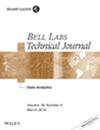下载PDF
{"title":"当前和未来的柔性波长路由交叉连接","authors":"Thierry Zami","doi":"10.1002/bltj.21626","DOIUrl":null,"url":null,"abstract":"<p>Existing and evolving telecommunication services rely upon transport infrastructure for their carriage, including that provided by wavelength division multiplexing (WDM) based networking. In order to maximize reach in the photonic domain, thus limiting the total number of costly and power-greedy optoelectronic regenerators required for reliable transport, optimization of wavelength routing cross-connect (WRXC) properties is essential. There are several relevant WRXC properties. These include low physical impact on optical channels, enabling usage of advanced modulation formats with high spectral efficiency, support for flexible wavelength allocation as well as multi-directional, colorless, and contentionless insertion/extraction of traffic, resilience against failures, and automatic lightpath setup. Other factors supporting WRXC deployment involve fair initial cost, compactness and modularity, and scalability to high connectivity and to significant add/drop capacity. Some of these features are a “must have” whereas others are a “nice to have.” This paper reviews the primary trends affecting current and future WRXC evolution considering these functionalities as well as the corresponding tradeoffs. ©2013 Alcatel-Lucent.</p>","PeriodicalId":55592,"journal":{"name":"Bell Labs Technical Journal","volume":"18 3","pages":"23-38"},"PeriodicalIF":0.0000,"publicationDate":"2013-11-27","publicationTypes":"Journal Article","fieldsOfStudy":null,"isOpenAccess":false,"openAccessPdf":"https://sci-hub-pdf.com/10.1002/bltj.21626","citationCount":"12","resultStr":"{\"title\":\"Current and Future Flexible Wavelength Routing Cross-Connects\",\"authors\":\"Thierry Zami\",\"doi\":\"10.1002/bltj.21626\",\"DOIUrl\":null,\"url\":null,\"abstract\":\"<p>Existing and evolving telecommunication services rely upon transport infrastructure for their carriage, including that provided by wavelength division multiplexing (WDM) based networking. In order to maximize reach in the photonic domain, thus limiting the total number of costly and power-greedy optoelectronic regenerators required for reliable transport, optimization of wavelength routing cross-connect (WRXC) properties is essential. There are several relevant WRXC properties. These include low physical impact on optical channels, enabling usage of advanced modulation formats with high spectral efficiency, support for flexible wavelength allocation as well as multi-directional, colorless, and contentionless insertion/extraction of traffic, resilience against failures, and automatic lightpath setup. Other factors supporting WRXC deployment involve fair initial cost, compactness and modularity, and scalability to high connectivity and to significant add/drop capacity. Some of these features are a “must have” whereas others are a “nice to have.” This paper reviews the primary trends affecting current and future WRXC evolution considering these functionalities as well as the corresponding tradeoffs. ©2013 Alcatel-Lucent.</p>\",\"PeriodicalId\":55592,\"journal\":{\"name\":\"Bell Labs Technical Journal\",\"volume\":\"18 3\",\"pages\":\"23-38\"},\"PeriodicalIF\":0.0000,\"publicationDate\":\"2013-11-27\",\"publicationTypes\":\"Journal Article\",\"fieldsOfStudy\":null,\"isOpenAccess\":false,\"openAccessPdf\":\"https://sci-hub-pdf.com/10.1002/bltj.21626\",\"citationCount\":\"12\",\"resultStr\":null,\"platform\":\"Semanticscholar\",\"paperid\":null,\"PeriodicalName\":\"Bell Labs Technical Journal\",\"FirstCategoryId\":\"1085\",\"ListUrlMain\":\"https://onlinelibrary.wiley.com/doi/10.1002/bltj.21626\",\"RegionNum\":0,\"RegionCategory\":null,\"ArticlePicture\":[],\"TitleCN\":null,\"AbstractTextCN\":null,\"PMCID\":null,\"EPubDate\":\"\",\"PubModel\":\"\",\"JCR\":\"Q1\",\"JCRName\":\"Engineering\",\"Score\":null,\"Total\":0}","platform":"Semanticscholar","paperid":null,"PeriodicalName":"Bell Labs Technical Journal","FirstCategoryId":"1085","ListUrlMain":"https://onlinelibrary.wiley.com/doi/10.1002/bltj.21626","RegionNum":0,"RegionCategory":null,"ArticlePicture":[],"TitleCN":null,"AbstractTextCN":null,"PMCID":null,"EPubDate":"","PubModel":"","JCR":"Q1","JCRName":"Engineering","Score":null,"Total":0}
引用次数: 12
引用
批量引用

 求助内容:
求助内容: 应助结果提醒方式:
应助结果提醒方式:


